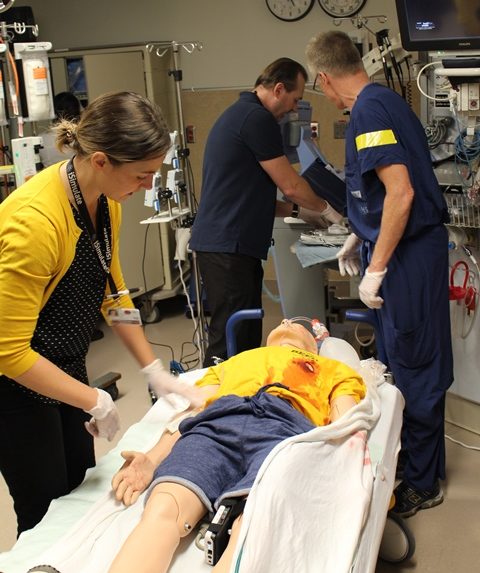By Jeffrey Tochkin, Caroline Nolan and Sarah Hartwick
Hospitals are experts in emergencies. Staff train for years to respond effectively and save lives daily.
But, when an emergency exceeds capacity and becomes a disaster—whether a flood, tornado, shooting or major collision—it requires a more coordinated response.
Disaster events in our communities are on the rise, and they regularly test hospitals throughout the country.
As the Regional Trauma Centre for eastern Ontario, preparing for disaster has become a part of the culture at The Ottawa Hospital. In 2019, this paid off when the hospital declared a Code Orange for the first time in five years.

Practicing for a disaster
Over the past few years, in collaboration with departments from across the hospital, The Ottawa Hospital’s Emergency Management team has revamped its corporate Code Orange Plan and has run regular training exercises to test it.
Following a number of incidents in the Greater Toronto Area in mid-2018, the hospital decided to run a major exercise to field-test its Code Orange Plan.
“Practice makes perfect,” said Dr. Andrew Willmore, the hospital’s Medical Director for Emergency Management. “We spend a lot of time thinking about what the best response to a Code Orange will be, and we leverage academic literature and experiences from other institutions. Once we have our policy, we have to test it. If it doesn’t work on the front lines to improve our response, we need to make changes.”
After six months of planning, in November 2018, the Emergency Management team ran the hospital’s largest-ever exercise: a simulated active shooter.
The exercise designers developed a scenario involving a shooter at a local convention centre. Over the 75 minutes, 20 casualties arrived at the hospital’s Civic Campus Emergency Department.

The primary goals for the day were to evaluate how patients were triaged, how patients moved through the department, and command post communication in the Emergency Department.
The exercise included dozens of departments and services from the hospital, with the majority from the Emergency Department, the Trauma Team and the Surgical Suites. To avoid putting any strain on regular operations in the Emergency Department, staff came in specifically to take part in the exercise. Controllers and Evaluators watched and recorded the activity. Staff from the hospital and from partners across the city, including Canadian Armed Forces Personnel, came to observe.
Realism was key in setting the scene for health-care providers taking part in the exercise. Volunteer medical students were in full “moulage” casualty make-up, and a simulation mannequin gave the team a life-like experience.
Behind the scenes: Planning the exercise
Designing such a large exercise takes expertise and attention to detail. In this case, the design team chose an in-situ simulation for the exercise, but has previously used tabletop exercises, drills, seminars and workshops with good results.
The in-situ and simulation was planned for a Friday morning before flu season was in full force, when the Emergency Department likely wouldn’t be over-capacity. Its aspects led to a collaborative effort between Emergency Department leadership, Simulation Centre Faculty and Staff, and Emergency Management staff.
Ahead of the exercise, regular planning meetings kept the design on track and prepared the participants for their roles. A “go/no-go” decision was held just before the start of the exercise to allow for last-minute flexibility and ensure real patients in the department wouldn’t be affected.
Real-life disaster: Code Orange at The Ottawa Hospital
Two months after the exercise, the lessons learned paid off when the hospital had to declare a Code Orange. On a Friday afternoon in January 2019, a double-decker city bus collided with a bus shelter at Ottawa’s Westboro transit station.
Within minutes of the news breaking, the hospital quickly activated the Trauma Team and declared a Code Orange. Response teams from all over the hospital converged on the Emergency Department to receive trauma patients. In all, 13 patients from the collision went to the Civic Campus, while six went to the hospital’s General Campus. The response was fast, effective and undoubtedly saved lives.
Many of the staff members involved that day credit the November exercise with preparing them and improving the hospital’s response at exactly the right time.
“It was important to have had [the simulation] fresh in back of your mind. That really helped,” said Dr. Adnan Sheikh, head of Emergency Radiology, in the days following the event. “That was the preparatory course, and Friday was the exam.”
Jeffrey Tochkin and Caroline Nolan are Emergency Management Coordinators at The Ottawa Hospital, and led the design of hospital’s largest-ever Code Orange exercise. Sarah Hartwick is a Communications Officer at The Ottawa Hospital.


